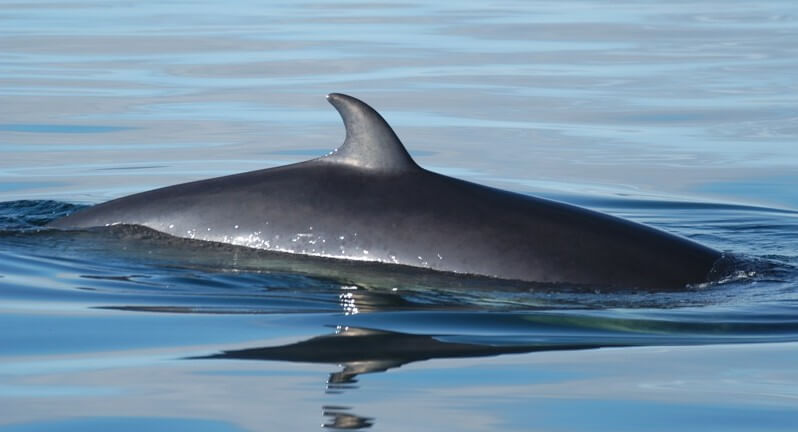Photo-identifying the minke whales of the Estuary is one of the objectives of the team at Mériscope, which is based in Portneuf-sur-Mer. What makes for an ideal photo to recognize these whales? A clear picture, taken perpendicular to the animal and with the sun at the photographer’s back. Each image is meticulously and systematically analyzed in the lab to determine whether the dorsal fin shows a scar, a gash or a notch. “The season is well underway,” says Dany Zbinden, researcher and founder of the group. This summer, his team is carrying out a new bioacoustics project as well as the biopsy sampling campaign – in its 3rd field season – which aims to understand the accumulation and impacts of halogenated flame retardants (HFRs) in St. Lawrence minke whales. The Group for Research and Education on Marine Mammals (GREMM) is also participating in the project by taking skin and fat biopsies from belugas.
In Franquelin, on July 14, a deafening noise awakens our collaborator at 4 in the morning. A whale blow? Perhaps. The animal must be quite close to the coast. The day before, she spotted a blue whale 3 km from shore. This individual is one of a minority (15-18%) of blue whales that lift their tail when they dive.
In Sept-Îles this week, Anik Boileau and one of her co-workers each spot two blue whales for a total of four individuals in the area. Anik Boileau is the founder of the Sept-Îles Education and Research Centre (CERSI). The projects being conducted by this researcher aim to identify the abundance and distribution of species present in the area and to understand the social dynamics of fin and humpback whales. She is also studying the issue of maternal investment in harbour porpoises, one of the few cetaceans that is able to give birth every year. A number of the carcasses of recovered porpoises are those of newborns. While some individuals die from illness, others may succumb to inadvertent separation from their mothers, suspects Anik Boileau. To study mother-calf bonds and the possible causes of separation, the team heads out to sea armed with a camera and a drone. In addition to the four blue whales, the team also spots five fin whales, a humpback, a minke whale and five harbour porpoises.
Every morning this week, in the Gaspé Peninsula between L’Anse-au-Griffon and Cap Gaspé, a whale-watching guide has been spotting the spouts of twenty or so large rorquals. Between the villages of Cloridorme and L’Anse-à-Valleau, three fin whales and three humpbacks are seen. On July 19, a captain in Percé encounters two humpback whales behind the municipality’s famous rock, as well as five minke whales. At the same time, he discovers other spouts on the horizon.
The team from the Mingan Island Research Station (MICS) leaves its study area in the Gaspé for a few weeks and will return in the fall to continue collecting data. Setting out from Longue-Pointe-de-Mingan, the team continues its work on the north shore of the Gulf. The animals are scattered, meaning the team must travel many nautical miles. In six days in the field, the team tallies six humpback whales, 20 fin whales, 30 or so minke whales, “loads” of harbour porpoises, a young North Atlantic right whale as long as their 7 m Zodiac, and, surprisingly, ten or so basking sharks.
This shark is the second largest shark and fish in the world, measuring about ten metres long and weighing about four tonnes. Like whales, it ingests large amounts of zooplankton and small fish, but uses a different technique. It swims with its mouth wide open, engulfing prey-laden water, which is immediately expelled through gill slits that retain the tiny organisms. Its large dorsal fin slices through the water surface, but the absence of breath betrays its ichthyological character (to know more about the difference between sharks and whales, see the most recent question from the public). These animals are studied by Jeffrey Gallant, President and Scientific Director of the Greenland Shark and Elasmobranch Education and Research Group (GEERG). He works in the Baie-Comeau area to conduct his research on Greenland sharks. He regularly informs us of whale sightings in this sector.
On July 15, a humpback caught the attention of the whale-watching industry in the Saguenay-St. Lawrence Marine Park . Thanks to MICS expertise, we are able to identify the unknown individual in photos taken by a captain. It is H694, a female discovered in 2007 and seen again only once before this summer, in 2016 by a team from Fisheries and Oceans Canada. Three fin whales are there as well, between Tadoussac and Les Escoumins, including Bp942, a.k.a. Piton. The fin whales are being researched by GREMM research assistants who board whale-watching boats to photo-ID large rorquals in the Marine Park.






